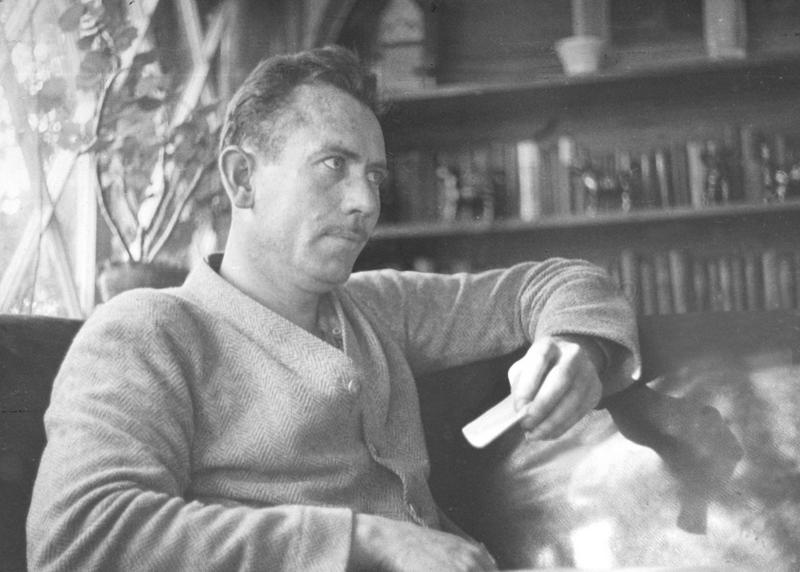John Steinbeck: Famous Author Biography, About, Facts, & Stuff You Didn't Know
By | February 25, 2021

If you went to high school in the United States, you definitely know the name John Steinbeck. Maybe you were annoyed when your teacher assigned you the 450-page The Grapes Of Wrath, but if you gave the book a shot, you probably learned a lot about the Great Depression, the Dust Bowl, and the deep impact it had on the lives of the American working class, as Steinbeck's work often dealt with the real world struggle of everyday people.
John Steinbeck's Early Life
John Steinbeck was born on February 27, 1902 in Salinas, California, an area that was known as the "Salad Bowl of America" thanks to its high production of lettuce. Living in this valley informed much of Steinbeck's writing, as he became deeply passionate about telling the often-ignored stories of the lives of blue-collar workers. Even in high school, Steinbeck was a prolific writer, often inviting his friends over to read his work and offer constructive criticism.
After graduating high school in 1919, Steinbeck enrolled at Stanford University. He studied creative writing, history, and marine biology, but after six years of failing to earn enough credits to graduate, he dropped out and picked up odd jobs to support himself while he pursued writing. In 1929, he released his first novel, Cup Of Gold, and soon after, he met his first wife, Carol Henning. It wasn't until 1935 that he released his first success, Tortilla Flat, and it took four more years to release his most revered work, The Grapes Of Wrath, about a Depression-era Oklahoma family on a road trip to escape the Dust Bowl and seek fortune in the golden plains of California.

Of Divorce And Men
In addition to big events like the Great Depression and Dust Bowl, Steinbeck also explored the different personalities he met as a farm worker in California, most acutely seen in the novella Of Mice And Men. Steinbeck pioneered the unusual "play-novelette" format, in which the book itself was meant to double as a script, but the initial attempt to adapt it for the stage fell flat. With a little tweaking from playwright George Kaufman, Of Mice and Men debuted on Broadway in 1938 and has been a mainstay production, with the most recent show ending in 2014. Fun fact: Steinbeck would have finished the novella sooner, but his dog actually ate his first draft.
Soon after, Steinbeck's personal life began to fall apart. He and Hennings divorced in 1941, and although he quickly remarried a woman named Gwyndolyn Conger, with whom he had two sons, it was no happily ever after. In 1948, Steinbeck's longtime friend, writing partner, and model for several of his characters, ecologist Ed Ricketts, was fatally injured in a train accident. Steinbeck rushed to be by his side, but Ricketts tragically passed before Steinbeck could reach him. When Steinbeck returned home, Conger had divorce papers waiting for him. He spent the next year in a deep depression, but before long, he began a romance with stage manager Elaine Scott and married her in 1950. The marriage lasted 18 years, until his death.
It was also around this time that Steinbeck believed the government started meddling in his affairs due to his political beliefs, which at the time were staunchly communist. According to his son, after the F.B.I. failed to dig up any dirt on him, J. Edgar Hoover instructed the I.R.S. to audit Steinbeck's taxes every year just to make his life difficult. Although no evidence ever surfaced of Hoover's alleged interest in him, Steinbeck wrote to the attorney general in 1942 to ask, "Do you suppose you could ask Edgar's boys to stop stepping on my heels? They think I am an enemy alien. It is getting tiresome." Steinbeck's political views softened somewhat around the time of the Vietnam War, largely influenced by a budding friendship with President Lyndon B. Johnson but likely also concern for his son, who was serving overseas.

Hollywood And Nobel
Steinbeck's most lauded work within the realm of Hollywood is East Of Eden, a loose retelling of the biblical account of Cain and Able, which was turned into a 1955 film of the same name starring the one and only James Dean. Unfortunately, the legendary actor died that same year but became the first actor to earn a posthumous Academy Award nomination for his performance in the film. (He didn't win, but costar Jo Van Fleet did.)
In 1962, Steinbeck won a Nobel Prize in Literature for his "for his realistic and imaginative writings, combining as they do sympathetic humor and keen social perception," but the good times were running out. Though Steinbeck had a history of physical ailments, what eventually took him down was the flu pandemic of 1968, which is estimated to have killed at least one million people worldwide. Even half a century later, however, Steinbeck's legacy is far from dead. As recently as 2020, Hollywood studios battled the author's family for the film rights to his work.

